More Efficient Engines

For over 100 years, internal-combustion engines have been the first choice for automotive power. Recently electric alternatives have been gaining popularity but they are just a small fraction of what’s on the road. Dethroning the internal-combustion engines isn’t going to happen anytime soon because they offer high power, practicality and low cost. However, these engines are being forced to evolve under federal and market pressures demanding they pollute less and deliver higher miles per gallon. To meet these challenges, a number of new internal-combustion engine technologies have been developed.
Advanced Cylinder Deactivation
Cylinder deactivation his isn’t a new concept. In 1981, Cadillac introduced cylinder deactivation on its V-8 engines. This technology could automatically switch off two or four cylinders when cruising to save gasoline. A good idea but Cadillac’s implementation wasn’t done very well. The “V-8-6-4 System” was far from a success.
Today, cylinder deactivation has been almost perfected. Engineers have added additional sensors and more accurate control algorithms. By the end of this decade, it is forecast that cylinder deactivation technology will have advanced to the point where V-6 and V-8 engines will reliably be able to cruise on just 2 cylinders. Estimates suggest that fuel consumption could be cut as much as 20 percent with this technology.
Electric Accessory Drives
Most of today’s engines drive alternators, water pumps, AC compressors and other accessories mechanically via a continuously running rubber belt. Problem is that don’t all need to be running all the time. An obvious solution would be to drive these accessories via electric motors which could be shut off. The problem is that standard 12 volt systems make this difficult because not enough power in a 12V system to drive typical accessories.
A solution to this problem is to step up the 12V voltage used in cars to 48 Volts. This allows the construction of more efficient electric motors which could be shut off when not needed. A system such as this will eliminate belt-related parasitic loads and this may yield fuel efficiency of 10-15%. We are told that Volvo is about to release several models with 48 Volt systems. According to Patrick Volvo of Schaumburg, a local Volvo dealer in Schuamburg, IL, one of the primary reasons that Volvo is going to 48 Volts is because they will have an e-Supercharger (electric supercharger) on their engines.
Camshaft-Less Engines
Internal combustion engines use intake valves to allow fuel and air to be drawn into their cylinders and exhaust valves to purge exhaust gases out. The opening and closing of these valves is generally actuated by rotating camshafts and a timing chain or belt. That may soon be considered old-school. Several manufacturers are working on electric solenoids to open/close engine valves. This allows two advantages: first, it takes far less energy for a solenoid to open and close a valve than a camshaft requires. Second, engineers can fine tune the opening and closing timing to match engine loads and speeds more accurately.
While research is quite promising, it’s looking like this technology is going to require the 48 volt systems that we discussed before. This technology is a few years away from implementation.





